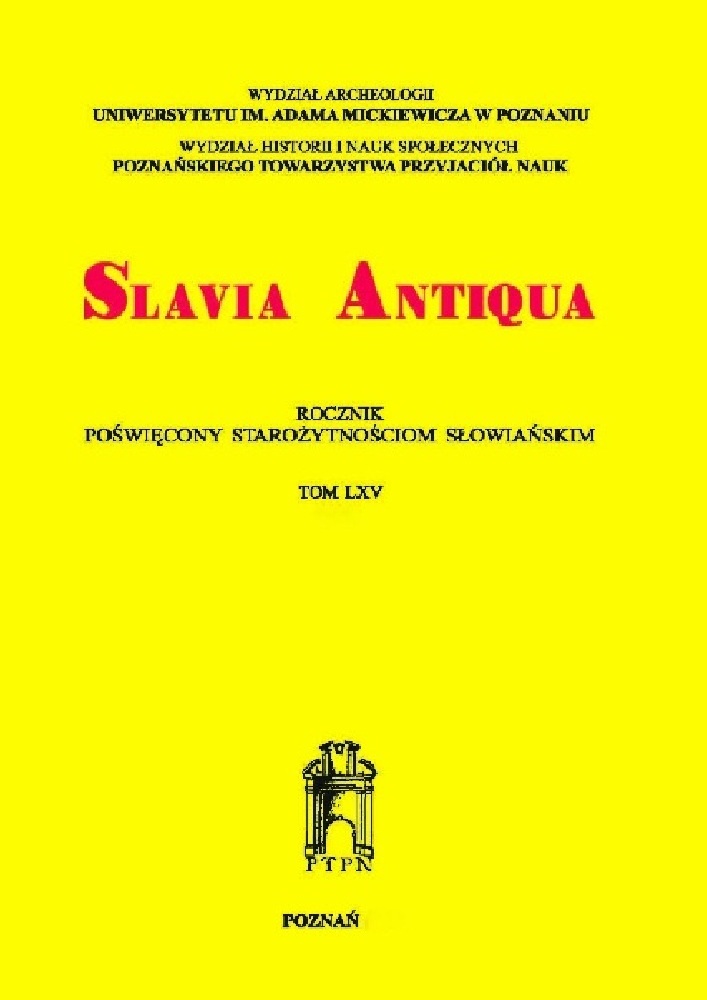Abstrakt
The article is a presentation of ethnogenesis of Slavs in the view of medieval chronicles. Hungarian medieval historiography served as a starting point of the reflection. The author describes how national “Prehistory” was presented in Hungarian chronicles and compares them with the general tendencies in medieval historiography to show the way in which native origins were created. It was a search for a common ascendant of the European people based on the Bible figure of Japhet and the way in which this tradition is related to facts known from ancient history (like the Trojan War) as well as geographical description based on ancient erudition. It was the common explanation of native origins in the entire Western and Eastern Christianity.As a result, the culture of medieval and Pre-Modern Europe united despite the political divisions.
Bibliografia
Banaszkiewicz J. 1979, Kronika Dzierzwy. XIV-wieczne Kompendium Historii ojczystej, Wrocław–Warszawa–Kraków, Zakład Narodowy imienia Ossolińskich. Wydawnictwo Polskiej Akademii Nauk.
Borst A. 1958, Der Turmbau von Babel. Geschichte der Meinungen über Ursprung und Vielfalt der Sprachen und Völker, Band 2, Teil 1, Stuttgart, Anton Hiersemann.
Borst A. 1959, Der Turmbau von Babel. Geschichte der Meinungen über Ursprung und Vielfalt der Sprachen und Völker, Band 2, Teil 2, Stuttgart, Anton Hiersemann.
Grzesik R. 2017, Гжесик, Рышард. Этногенез славян в польской исторической рефлексии ХХ-ХХІ вв., „Studia Slavica et Balcanica Petropolitana“ 2 (22), s. 107-121.
Kersken N. 1995, Geschichtsschreibung im Europa der „nationes“. Nationalgeschichtliche Gesamtdar-stellungen im Mittelalter, Köln–Weimar–Wien, Böhlau Verlag.
Kniezsa I. 1938, Ungarns Völkerschaften im XI. Jahrhundert, „Archivum Europae Centro-Orientalis“ 4, s. 241-412.
Kónya P. a kol. 2013, Dejiny Uhorska (1000-1918), Prešov, Vydavateľstvo Prešovskej univerzity v Prešove.
Kotlińska J. 1996, Symboliczne znaczenie ptaka turula w kulturze węgierskiej, „Proglas” [ed. Kraków], 4, s. 40-42.
Kovacsics J. 1995, A történeti demográfia válaszai és nyitott kérdései Az Árpád-kori népesség számára vonatkozóan, w: J. Kovacsics (red.), A honfoglalás és az Árpád-kor népessége. Az 1995. február 16-án Budapesten megrendezett Népesedéstörténeti Konferencia előadásai, Budapest, Központi Statisztikai Hivatal (Magyarország történeti demográfiája 1), s. 8-36.
Kristó Gy. 2000, Magyarország népei Szent István korában, „Századok” 134, s. 3-44.
Kürbisówna B. 1952, Studia nad Kroniką wielkopolską, Poznań, Wydawnictwo Poznańskiego Towarzystwa Przyjaciół Nauk. Modzelewski K. 2004, Barbarzyńska Europa, Warszawa, Wydawnictwo Iskry.
Moór E. 1956, Die Ausbildung der Betriebsformen der ungarischen Landwirtschaft im Lichte der slawischen Lehnwörter, „Studia Slavica Academiae Scientiarum Hungaricae“ 2, s. 31-117.
Nowak J. 2018, Piastuni dziejów. Wizerunki narodów europejskich w polskiej refleksji romantycznej, Warszawa, Instytut Slawistyki Polskiej Akademii Nauk.
Pomian K. 2009, Przeszłość jako przedmiot wiary. Historia i filozofia w myśli średniowiecza, wyd. 2, Warszawa, Wydawnictwa Uniwersytetu Warszawskiego.
Snyder Ch. 2011, Exploring the World of King Arthur, wyd. 2, London, Thames & Hudson Ltd.
Spychała L. 2011, Studia nad legendą dynastyczną Arpadów. Między pulpitem średniowiecznego skryby a „warsztatem” współczesnego badacza, Wrocław, Wydawnictwo Uniwersytetu Wrocławskiego („Acta Universitatis Wratislaviensis”, No. 3329, Historia 182).
Licencja
Prawa autorskie (c) 2020 RYSZARD GRZESIK

Utwór dostępny jest na licencji Creative Commons Uznanie autorstwa – Bez utworów zależnych 4.0 Międzynarodowe.

